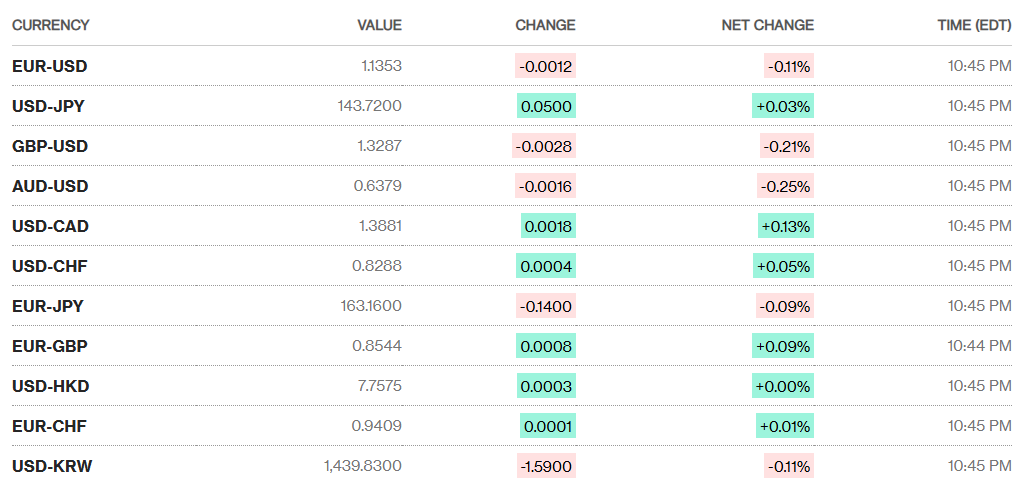The greenback started the new trading week with a slight gain as investors braced for a slew of economic data that could provide the first signs of how U.S. President Donald Trump's trade war is affecting the economy.
Despite the perceived support, the greenback is still headed for its biggest monthly decline in nearly 2-1/2 years as Mr Trump's moves shake confidence in the stability of US assets.
The greenback has lost more than 4% of its value against both the euro and the yen so far this year, despite a slight recovery late last week thanks to more positive signs in US-China trade talks.
Last week, both countries appeared to have pulled back from the brink of tension when the Trump administration signaled a willingness to reduce tariffs on the world's second-largest economy, and China exempted some US imports from its 125% tariff.
However, while President Trump has claimed progress has been made and has spoken by phone with President Xi Jinping, Beijing has denied that any trade talks are taking place. US Treasury Secretary Scott Bessent has also refused to confirm that tariff talks are taking place.
"The next important chapter will be whether these fluctuations have impacted real decisions in the economy, especially in the US labor market," said Chris Turner, global head of markets at ING.
Investors are therefore turning their attention to the US April jobs report due out this Friday, with expectations of a sharp slowdown in the pace of hiring.
This week, the US will also release first-quarter GDP data and the core PCE inflation index - the US Federal Reserve's preferred inflation measure. In Europe, preliminary GDP and inflation figures will also be released.
In Australia, inflation data is due out on Wednesday, but it is unlikely to be enough to dampen expectations that the Reserve Bank of Australia (RBA) will cut interest rates next month.
The Australian dollar fell 0.25% to $0.6379 this morning, off recent highs, while the New Zealand dollar also fell 0.17% to $0.5949.
“AUD/USD could break above resistance at $0.6464, but this has been a strong resistance level this month,” Commonwealth Bank of Australia strategist Joe Capurso said in a note.
In Canada, voters head to the polls today. Polls show the ruling Liberal Party with a narrow lead, while online predictions give them a big advantage. Options markets show that investors are not expecting major volatility in the currency market, with the Canadian dollar down 0.13% this morning at 1.3881 CAD/USD.
Meanwhile, the Bank of Japan (BoJ) is expected to announce its monetary policy decision this Thursday.
Although there is no expectation of a policy change, investors will focus on the economic outlook and the BoJ's response direction in the context of global economic uncertainty, especially when the US-Japan trade negotiations are expected to address the exchange rate issue.
On Monday morning, Atsushi Mimura, Japan's top diplomat in charge of currency, denied a report in the Yomiuri newspaper that Mr. Bessent had said in a bilateral meeting that the United States wanted a weak dollar and a strong yen.
Elsewhere, the euro fell 0.11% to $1.1353 this morning, while the pound fell 0.21% to $1.3287.
Source: https://thoibaonganhang.vn/sang-284-ty-gia-trung-tam-giam-3-dong-163454.html




![[Photo] Journalists moved to tears at the Memorial Service for the soldiers who died in Gac Ma](https://vphoto.vietnam.vn/thumb/1200x675/vietnam/resource/IMAGE/2025/5/30/9454613a55c54c16bf8c0efa51883456)


![[Photo] National Conference "100 years of Vietnamese Revolutionary Press accompanying the glorious cause of the Party and the nation"](https://vphoto.vietnam.vn/thumb/1200x675/vietnam/resource/IMAGE/2025/5/30/1cf6cd5c8a934ebfa347028dcb08358c)
![[Photo] A delegation of 100 journalists from the Vietnam Journalists Association visits the soldiers and people of Truong Sa island district.](https://vphoto.vietnam.vn/thumb/1200x675/vietnam/resource/IMAGE/2025/5/30/0984a986227d4e988177f560d2e1563e)
![[Photo] General Secretary To Lam receives Chief of the Central Office of the Lao People's Revolutionary Party](https://vphoto.vietnam.vn/thumb/1200x675/vietnam/resource/IMAGE/2025/5/30/140435f4b39d4599a3d17975dfb444c5)





















































































Comment (0)